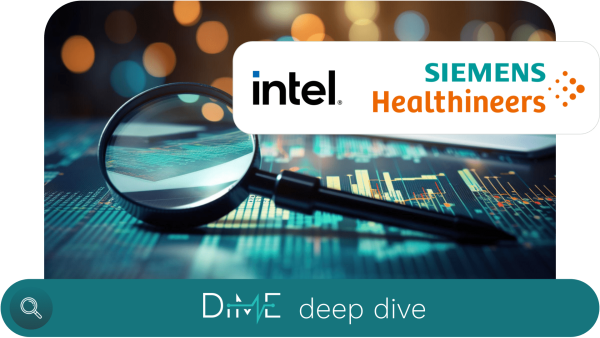
AI at the edge: How Intel and Siemens Healthineers are redefining AI deployment in healthcare
Overview
As the healthcare industry continues to explore the potential of artificial intelligence (AI), a persistent challenge remains: how to support AI implementation that is scalable, sustainable, and seamlessly integrated into existing clinical workflows.
Intel and Siemens Healthineers have demonstrated exactly that—offering a model for how AI deployed at the edge delivers real-world clinical and operational benefits without adding burden to already overextended healthcare systems and their providers. Together, they have brought this vision to life through an impactful deployment at Geisinger, a nationally recognized health system with a large, rural footprint.
AI deployment with the infrastructure of today
“Many are surprised to learn how deeply embedded Intel is in healthcare,” noted Alex Flores, General Manager, Health and Life Sciences Vertical at Intel Corporation. “Most of the devices in hospitals today—from imaging machines to laboratory systems—are powered by Intel architecture. We’ve long powered the infrastructure backbone. Now, we’re extending that infrastructure to support AI capabilities at the edge.”
Unlike traditional AI models that rely on the cloud for computation and data processing, edge AI allows models to run locally—on-site, on-device, and often on the hardware already in place. This approach delivers significant benefits: lower latency, improved data privacy, and, critically, the ability to make real-time clinical decisions. “There’s a common misconception that deploying AI at the edge requires entirely new systems,” Flores added. “But in many cases, it’s about optimizing what already exists.”
For Siemens Healthineers, whose mission is to enable healthcare professionals to deliver high-quality, patient-centric care, selecting the right technology partner is paramount.
“Our expertise is clinical innovation,” said Peter Shen, Head of Digital & Automation – North America at Siemens Healthineers. “We rely on partners like Intel to bring the technological sophistication required to make advanced solutions not only possible but practical. And that’s especially critical when we’re talking about AI at the edge.”
By embedding AI directly into their imaging and therapeutic systems—rather than sending data to remote cloud servers for processing—Siemens Healthineers can deliver timely, actionable insights to clinicians right at the point of care. The result is a smoother, faster, and more reliable clinical workflow.
“AI becomes truly powerful when it’s invisible,” Shen said. “When it supports decision-making in real time without adding friction or complexity to the provider experience.”
Accelerating treatments for better patient outcomes
One of the most impactful applications of this partnership is taking place at Geisinger, where Siemens and Intel worked together to modernize the radiation therapy planning process. Clinicians needed a faster, more efficient way to generate radiation treatment plans without compromising precision or safety.
Traditionally, treatment planning required dosimetrists to manually contour cancerous tumors and surrounding healthy tissues on medical images—a painstaking process that could take hours or days. For patients, that meant delays in beginning therapy and longer periods of uncertainty during an already stressful time.
Through collaboration with Intel, Siemens Healthineers deployed AI-Rad Companion that automates the image segmentation process. Because the solution runs at the edge—on Siemens’ imaging systems optimized by Intel processors—it delivers near-instant results without needing to transmit sensitive data off-site, reducing exposure to risks such as unauthorized access, data breaches, and potential HIPAA compliance issues.
“By embedding the AI into the system itself, we enable clinicians to act quickly and accurately,” said Shen. “This is precision medicine in action. Patients start treatment sooner and with greater confidence that healthy tissue will be spared.”
Crucially, Geisinger did not need to invest in new imaging systems or additional servers. Intel and Siemens worked together to ensure the AI model could be deployed on existing infrastructure, including devices that were several years old. This not only reduced implementation time and cost, but also mitigated disruptions to clinical workflows.
“Adding a separate edge server or bolt-on solution introduces cost, complexity, and security concerns,” said Flores. “By optimizing the AI to run directly on Intel central processing units (CPUs) already in place, we eliminate those barriers—and make the solution much more scalable.”
That scalability proved key. After initial success at one site, Geisinger was able to rapidly expand the solution across 11 facilities serving over 3 million patients in Central Pennsylvania, maintaining performance and consistency without relying on additional bandwidth or cloud infrastructure.
AI on the edge: A scalable model for healthcare

Beyond radiation oncology, Siemens and Intel are collaborating on edge AI applications across multiple modalities. One example: cardiac magnetic resonance imaging (MRI). Imaging the heart—an organ in constant motion—requires highly optimized algorithms that can capture precise images in milliseconds.
“For this use case, we needed to do more than just process the image,” said Shen. “We had to optimize for motion, capturing a crisp, accurate view of the heart in real-time. That was only possible by working with Intel to integrate the AI at the point of image acquisition itself.”
The result is a dramatic improvement in image quality, speed, and diagnostic confidence, benefiting not just clinicians but also patients who may receive faster and more accurate diagnoses. Image processing is now 5.5 times faster, with no degradation in accuracy. Near-real-time cardiac MR clinical exams can be analyzed in under a second, enabling timely decision-making at the point of care.
As more healthcare organizations consider how to harness AI, both Shen and Flores offer a critical piece of guidance: start with a real clinical problem and partner to solve it thoughtfully.
“There are too many AI solutions searching for problems,” said Flores. “This work is the opposite. It’s a real, clinically grounded use case delivering measurable impact.”
He continued, “With the right partners, edge AI solutions are not only possible—they’re increasingly plug-and-play. You can implement them today without needing to redesign your entire system.”
For Intel and Siemens Healthineers, this is only the beginning. As health systems look for new ways to increase efficiency, reduce clinician burden, and deliver more personalized care, the edge is proving to be a powerful place to start.



